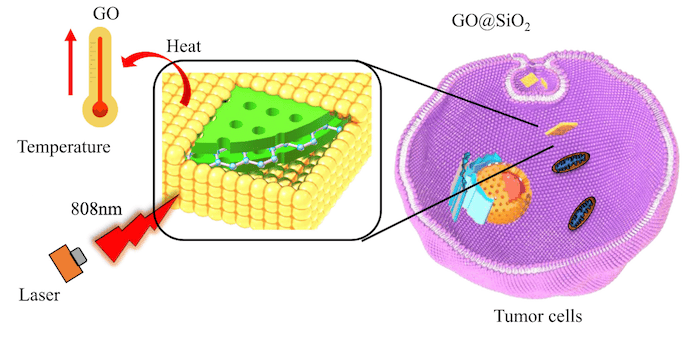
[Image above] Researchers in China developed a new graphene oxide-templated gold nanosheet that shows promise in photothermal treatment of cancer. Credit: He et al., International Journal of Nanomedicine (CC BY-NC 3.0)
After an emotionally tumultuous week following the United States presidential election, I was not ready for the news on Sunday that longtime Jeopardy! host Alex Trebek had died.
Trebek hosted the syndicated game show for 37 seasons, starting from its revival in 1984. In March 2019, he announced that he was diagnosed with stage 4 pancreatic cancer. Yet he continued in his role as host even while undergoing treatment and filmed his last episode on October 29, just over a week before his death.
Throughout the last year, Trebek spoke candidly about undergoing chemotherapy treatment to fight the cancer. Chemotherapy uses chemicals to kill fast-growing cells in the body. But though it is one of the most common treatments for cancer, chemotherapy puts an enormous strain on patients’ bodies because of the indiscriminate manner in which it kills both healthy and cancerous cells.
In recent years, doctors have emphasized investigation and use of alternative therapeutic strategies rather than traditional methods of surgery, chemotherapy, and radiotherapy, which can be extremely taxing on the body.
Photothermal therapy is one newly developed treatment method that holds much promise. This minimally invasive and local treatment induces cell death through thermal ablation, i.e., destruction of tissue by extreme heat. The heat is generated by using electromagnetic radiation to heat special molecules called photothermal agents that are placed in the tumor tissue.
Numerous types of photothermal agents are being investigated for use in photothermal therapy, including near-infrared fluorescent dyes, nanomaterials, and small organic molecules. Among them, gold nanomaterials with different structures are especially promising because of their inherent biological inertness, excellent photothermal conversion capability, and tunable large absorption cross-section in the near-infrared region, among other benefits.
In a recent open-access study, researchers from Central South University in China and a colleague from Affiliated Hospital of Guangdong Medical University explored the potential of gold nanosheets templated on graphene oxide for use as photothermal agents.
They explain in the introduction that graphene oxide is an ideal candidate for new biological applications because of several characteristics, including excellent biocompatibility, nontoxic nature, easy surface modification, and excellent adsorption capacity in the visible and near-infrared regions.
Several previous studies have investigated graphene oxide for photothermal therapy, and based on those results, “we believe the photothermal conversion efficiency could be significantly enhanced by coupling with 2D gold nanosheet on the template of [graphene oxide],” the researchers write.
They created the proposed photothermal agent in a three-step process, which is illustrated in the schematic below. First, they coated commercial graphene oxide with a mesoporous silica layer through the sol-gel method using hexadecyltrimethy-lammonium bromide (CTAB) as a stabilizer and template. Then they anchored small gold seeds (~4 nm) to the positive-charged surface of the mesoporous graphene oxide–silica composite through electrostatic interaction. After removing excess gold seeds, they used the gold growth method to prepare 2D gold nanosheets on the surface of GO@SiO2@Au seeds.

Schematic illustration of the GO@SiO2@Au nanosheet hybrid formation for photothermal therapy of cancer cells. Credit: He et al., International Journal of Nanomedicine (CC BY-NC 3.0)
The researchers conducted some preliminary tests on the nanosheets’ photothermal properties and biocompatibility before testing the nanosheets in vitro with colorectal cancer cells (KM12C). Results of the in vitro tests—which investigated the effectiveness of various concentrations of graphene oxide-template gold nanosheets with laser irradiation treatment (0.3 W/cm2 for 20 min)—showed the nanosheets were highly successful at killing cancer cells.
“When the concentration of GO@SiO2@AuNS hybrid was increased from 10, 50, to 100 μg/mL with [near-infrared] laser irradiation, the cell viability was decreased to about 61%, 35%, and 10%, respectively,” they write.
Overall, they concluded that the results suggest “this novel 2D core-shell gold hybrid might provide potential applications in cancer treatment.”
The open-access paper, published in International Journal of Nanomedicine, is “Graphene oxide-template gold nanosheets as highly efficient near-infrared hyperthermia agents for cancer therapy” (DOI: 10.2147/IJN.S265134).
Author
Lisa McDonald
CTT Categories
- Biomaterials & Medical
- Nanomaterials


